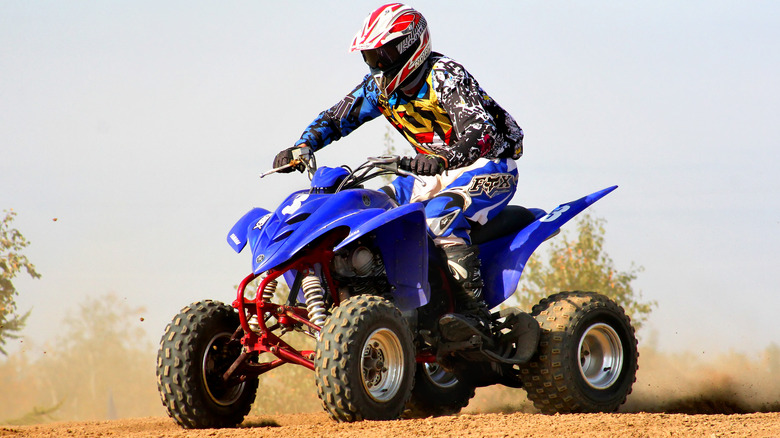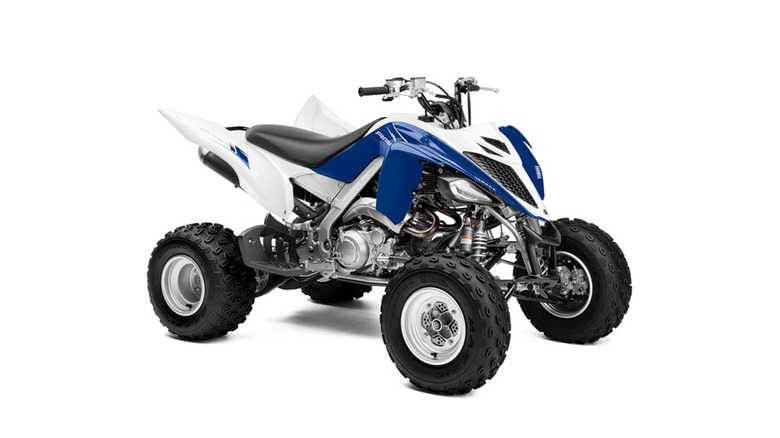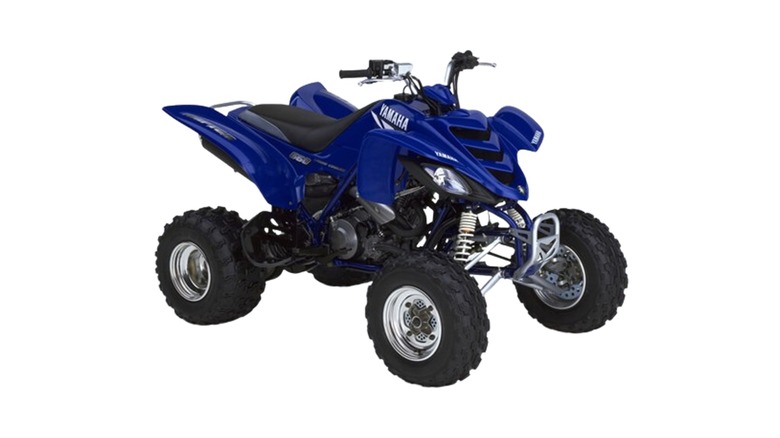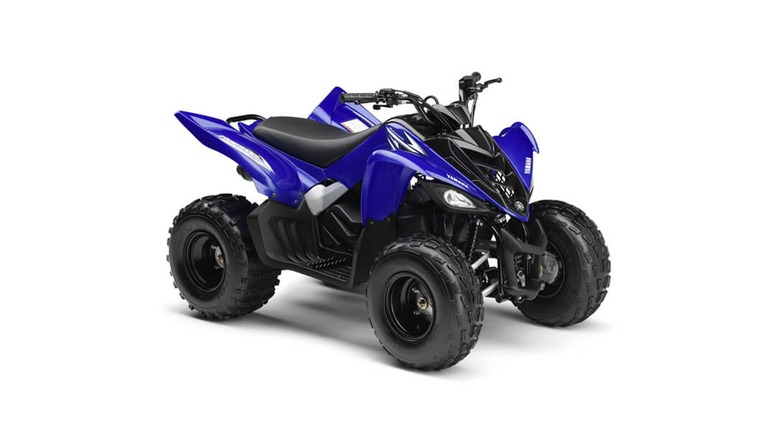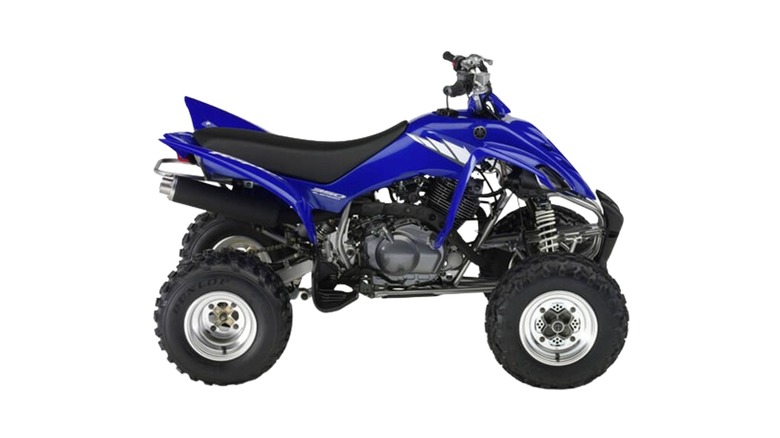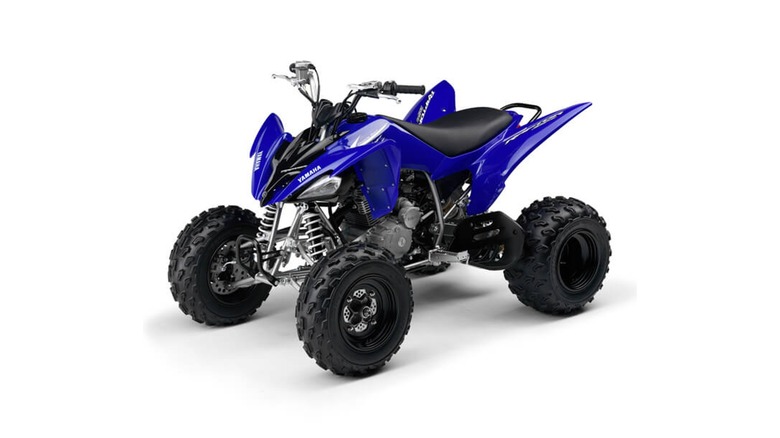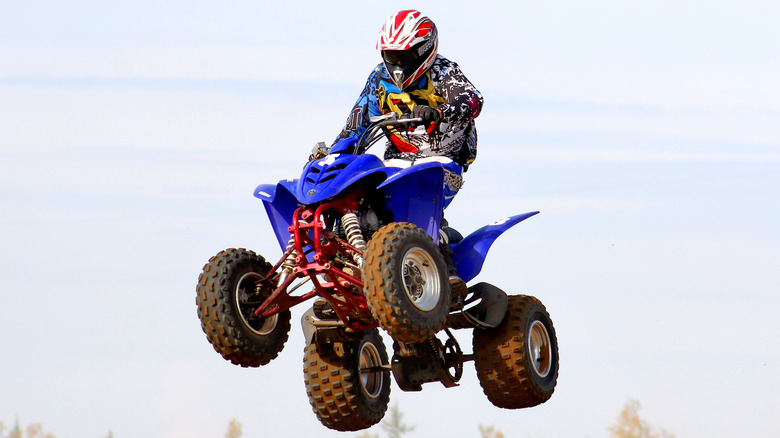5 Of The Best Yamaha Raptor Years Ever Made
Yamaha is a well-known name in the worlds of music and technology, making products like the Yamaha silent electric guitar among other, more standard Yamaha microphones and other devices. In 1955, part of the company separated to form one of the most influential businesses in the automobile and racing industries, the Yamaha Motor Company.
During the 1980s, the Yamaha Motor Company decided to shift its focus from motorcycles to ATVs. While its earlier 2-stroke engine models boasted powerful engines and fast speeds, it wasn't long before the company had to make a change as a result of emissions restrictions from the EPA.
The Yamaha Raptor series was born in 2001, starting with the Yamaha Raptor 600-series. The Raptor offered an array of quads with modern designs, improved suspension, and improved rider comfort, not to mention the greener, overhauled four-stroke engines. One of the Raptor's defining aspects is its versatility. Many models were designed to overlap the worlds of sports and leisure, and you can find quads for all skill levels in the series. Today, the Yamaha sells an impressive range of Raptors with well-regarded handling, power, and torque. Let's explore some of the greatest models made in the Yamaha Raptor series.
Yamaha Raptor 700R
Yamaha's Raptor 700R holds a worthy position at the top of our list as one of the best-selling sport quads of all time. The Raptor 700R launched in 2006, and though it has gone through a series of upgrades and refinements, the ATV is still one of the favorite sports quads today.
The Raptor 700R, not to be confused with the Yamaha YFZ450R, is known for its incredible speeds and low torque, which has helped it to win accolades from ATV magazines. The latest model is available in three editions: the 700, 700R and 700SE. While the Raptor 700 only has preload-adjustable suspension, you can take advantage of the Raptor 700R's fully adjustable suspension for riding on all terrain types. For a further upgrade, consider the 700R SE, which offers an improved rear brake mechanism.
In stock form, the Raptor 700R can reach top speeds of 80 mph, but an additional 10-15 mph can be added with some modifications. Overall, the Raptor 700R is a very popular model from Yamaha because of its speed and rider comfort.
Yamaha Raptor 660
The glory of the Yamaha Raptor 700R cannot be discussed without the mention of its important predecessor, the Raptor 660. Manufactured back in 2001, the Raptor 660 was a staple ATV that helped to influence the success of its older brother, the Raptor 700R.
Reaching speeds of up to 75 mph, the Raptor 660 boasted impressive top performance. It was built during the transition from two-stroke to four-stroke engines as concerns about emissions grew. The Raptor 660 featured a 36-horsepower liquid-cooled 660cc engine with over 10 inches of ground clearance for riding on rough surfaces.
Despite its impressive range of specifications, the Raptor 660 wasn't free of faults. One of the biggest problems was its top-heavy center of gravity, which could lead to instability and other nightmares for riders. That being said, it was one of the fastest sports quads of its time, and it marked a bold start to what would become the influential Raptor series. At the time of its release, the Raptor 660 became quickly recognized as a hit in the ATV world, with MotorTrend describing it as "a mechanical predator screaming through the woods." Yamaha stopped making the Raptor 660 in 2005, before releasing the Raptor 700R in 2006.
Yamaha Raptor 90
The Yamaha Raptor 90 was a major step up from its previous version aimed for younger drivers: the Raptor 125. Designed for riders 10 years and older, the Raptor 90 features a 89.9cc air-cooled engine, with a reasonably downsized weight of 279 pounds in comparison to full-size ATVs, which are typically at least twice that amount.
One of the biggest upgrades of the Raptor 90 from its previous models is the inclusion of a reverse. This offered an easier way to get out of trouble when stuck in tight spaces. Its lower seat height is an additional bonus for younger riders.
Especially for children, safety is a number one priority when riding an ATV. As such, Yamaha has equipped the Raptor 90 with a bundle of safety features to keep your kids out of trouble. There's a reduced speed limit for preventing accidents and a throttle limiter for limiting acceleration. The Yamaha Raptor 90 also features an electric start, which can make it easier for beginners. The Yamaha Raptor 90 is still in production today, and you can purchase the latest 2023 model for a retail price of $3,299.
Yamaha Raptor 350
Yamaha's Raptor 350 ATV was another influential quad that came out of the early 2000s. Inspired by Yamaha's Warrior 350, the Yamaha Raptor 350 had a long production lifespan from 2004 to 2013. This mid-bore quad offered a smaller engine with a displacement of 349cc, making it perfect for those transitioning from a beginner's model like the Raptor 90 to a full-sized model like the Raptor 700R.
Fan-favorite features of the Yamaha Raptor 350 include an improved braking system and a shift lever for reversing in any gear. The Raptor 350 also boasted a 6-speed transmission and strong grip wheels for riding any terrain.
As a well-built, versatile model, the Yamaha Raptor 350 became commonly used in both sports and recreational industries. Its mid-range specs meant the model's top speed is approximately 63 mph, which places it between the Raptor 90 and 700R. While it may not have been a popular choice for those seeking the aggression of the Raptor 660R, the Raptor 350 was an excellent lightweight counterpart.
Yamaha Raptor 250
The Yamaha 250 was a quad built for adventure, which flourished in a five-year lifespan from 2008 to 2013. Avid motor racers will notice the Raptor 250 bears resemblance with another long-time favorite, the Yamaha Blaster. After being a favorite in the ATV industry for nearly 20 years, the Blaster was discontinued in 2006 due to growing concerns from the EPA about the noise, safety, and emissions related to two-stroke engines.
In response, Yamaha built the Raptor 250—a four-stroke alternative with a similar size and a 249c engine. While some riders were left disappointed by the then-lower power demands of a four-stroke engine, Yamaha made plenty of improvements that would turn the Raptor 250 into a hit. The company focused on improving the handling of both the front and rear tires. Yamaha also gave the design an overhaul, which included improved riding comfort. Despite the Blaster offering higher power (after tweaks), both models can be easily upgraded with modifications, so you can enjoy a rider experience that suits your preferences.
Overall, the Raptor 250 was a staple ATV that set up a bright future for four-stroke quads as two-stroke engines began to phase out.
Methodology
From its roots to its refined modern quads, we've selected Yamaha Raptor models that have each played an important role in the series' rich history. We've also collected the opinions of expert voices from leading ATV magazines, including Dirt Wheels, so you can get a glimpse into how well the quads ride as well as their history.
